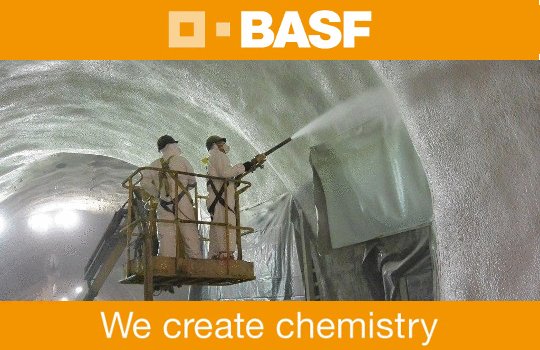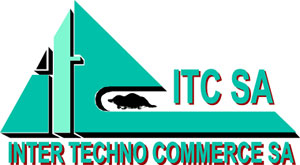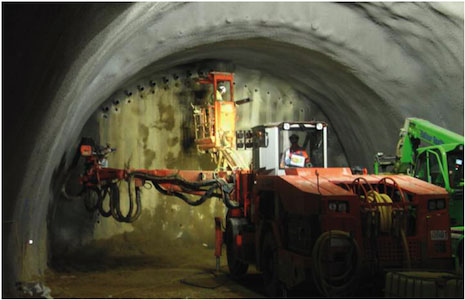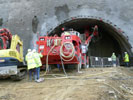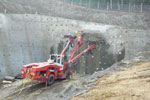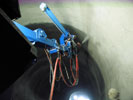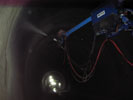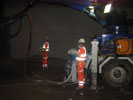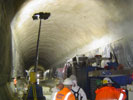Shani Wallis, TunnelTalk
All 80,000m2 of the Hindhead highway tunnel arch in the UK is fitted with a spray-applied waterproofing system. TunnelTalk visited the project to see it in application and to know how it provided the basis for accruing other value-engineering savings on the 1.8km long twin-tube tunnel contract.
- The tunnel was described as particularly dry during excavation with few areas of ground-water dampness and no instances of dripping water ingress. Even under the shallowest 18m cover on the diagonal to the rim of what is known as the Devil's Punchbowl in southeast England, the predominantly weak sandstone geology exhibited competent characteristics.
-

Twin tube portal
- "The weakest ground is at the portals where we used the canopy pipe pre-excavation support system," said Roger Bridge, Tunnel Manager for Balfour Beatty, the construction contractor. "The sandstone is actually sensitive to water and we had to adopt an mist-flushing system for the drill rigs as well as a misting dust suppression system for the tunnel excavator and a self-cleaning scrubber unit for controlling dust at the face and at the sizer that fed the continuous conveyor muck haulage systems."
- The key variable for maintaining ground stability was adjusting the length of each top heading round from between 1m and 2m, and closing the invert of each bench 3m behind. "Bolting was not required in the weak sandstone and we eliminated the use of lattice girders by adopting reflectorless survey techniques," said Bridge. "We also worked with VMT on the development of a profiling system for accurate excavation. Only steel or poly-fibre reinforced shotcrete was used as the primary support, with GRP spiling applied for extra support where necessary. Steel spiles were installed outside the primary lining profile where required. Face nailing was a nominated face support method but it wasn't needed."
- Speaking for the owner, Paul Arnold, Senior Manager and Project Sponsor for the Highways Agency said the decision making process started with accepting the initial shotcrete lining as the structural support and followed the contractor's value engineering proposal to apply poly-fibre shotcrete as the final fire-resistant finish. "This meant we had to use a different method for the waterproofing. It would have been difficult to spray the final shotcrete lining against a sheet membrane in the crown. We knew of spray and paint applied products on the market and since we were well into excavation by that time, and assured that there were no major sources of water ingress, against which the products we were looking at would not have been appropriate, we approved the use of the Masterseal product."
-

Spray-on waterproofing as part of a composite shotcrete lining
- Dry powder product
The Masterseal 345 product is manufactured in the United States and is a polymer rich powder that is basically the same raw material used to produce PVC membranes. It requires only water as a mixing agent and is applied using the contract's existing shotcreting crews and equipment, introduced water to the dry-mix at the nozzle of the spraying boom. - It is described as a significant improvement and quite different to BASF's earlier Masterseal 340 product. It is said to have a faster curing time; needs only one instead of two layers to ensure a consistent 3-5mm layer thickness; and has a more robust bond with the substrate. The 4 bar compressed air application is said to resist pull off forces of between 1.1 to 2kN/m2 on average. "It is often latent particles and contamination on the surface of cast concrete that cause bond failure," said Dimmock. "Application against a clean, regulated shotcrete surface provides a better key for the spray-applied polymer."
- "Masterseal 345 is geared specifically towards application in tunnels," said Richard Foord, the BASF representative in the UK. "It is less sensitive to the climate characteristics and less sensitivity to the quality of the substrate. Unlike two-part spray or paint applied waterproofing systems, it requires no B component catalyst - all of which are typically quite toxic and flammable; no specialist equipment, no specially trained crews; and no special PPE protective gear."
-

Computer settings....
- Application cycle
"The ease of using the product is a major advantage on the application side," said Bridge. "We used the same workers as those who applied all the shotcrete needs on the contract and fitted a Meyco Piccola dry spay pump to the Potenza robots to bypass the integral wet mix pump. This retained the Logica computer-controlled action of the spraying boom to apply a 5mm layer of waterproofing against the primary shotcreted surfaces." - In the tunnel, a crew of three was watched applying the product during the visit - one operating the robot, another emptying the bagged product into the dry-mix rotor pump hopper, and the third responsible for quality assurance.
- Each waterproofing cycle started with the Potenza robot air-blasting the substrate to remove dust and other latants and spraying the surface with water. "Some dampness is needed for optimum application and it suppresses dust," said Foord. Once the spraying parameters are entered into the Logica's computer system, a 2.5m long round of 5mm thick application across the full 11m arch span of the two-lane profile took about one hour. This speed of application is one of the greatest economic advantages of the system.
-

....for the waterproof spraying cycle
- The total 40,000m2 arch of 5mm thick Masterseal 345 was applied to the northbound tube in 4.5 weeks using two robots on a 24h/day, 7 days/week availability and working around other activities in the tunnels.
- The experience
Hindhead is the largest application of spray-on Masterseal 345 waterproofing in the world to date. Its 80,000m2 application overtakes the 60,000m2 applied in the open cut and conventional excavation approaches of the North-South Bypass Clem Jones highway tunnel in Brisbane, Australia, to the point where the segmentally lined TBM drives take over for the passage under the river. Following the Hindhead experience, the system is being considered by designers for application in the SCL (spray concrete lined) underground stations and intermediate access/ventilation/emergency exit shafts on London's Crossrail project. - During the visit to Hindhead, the limitations of the system were acknowledged. "Like all spray or paint applied products, it is not possible to spray directly against highly saturated substrates or against running water ingress," said Dimmock. "Any such situation would have to be pretreated to stem or divert excessive inflow." "This is less significant than it was with the previous more sensitive Masterseal 340 product," said Foord, "but still a limitation that requires active management prior to the membrane application".
|
- Independent test results are available to confirm that the product, once applied, has an ability to expand 100% times it own thickness. "This provides an integrity to bridge any cracks in the substrate" said Dimmock. Answers came from two directions when asked about future cracks developing in the composite lining, creating a serious channel for water ingress through the 200mm primary support, the 3-5mm waterproof membrane, and the 150mm final lining.
- "In the first instance, the lining design specification limits cracks in the primary lining, to a maximum of 0.5mm for example, using fibre reinforcement and high quality shotcrete specifications," explained Dimmock. "Secondly, we need to ensure our specifications call for membranes with crack bridging properties well in excess of the design crack widths. Typically the 345 spray membrane can cope with crack widths equal to its thickness of application, for design purposes. This safety margin allows us to cover cracks that are outside those that can be controlled in the design specifications." Literature that accompanies the product also explains that
-

Cast side walls for reflector pain and easier wash down
- there can be no migration of water between the membrane and the substrate. Should a leak appear in the composite structure, that is exactly where the leak is occurring. As a result there is no chasing the source of a leak and, despite the fact that using grout injection to seal water leaks can be problematic, the leak can be seen and readily repaired with the most effective of modern epoxy and polyurethane resins.
- When asked, it was confirmed that there is no long term insurance applied specifically to the waterproofing system of the tunnel and that Balfour Beatty has the contractual three-year maintenance liability period after the opening of the new road. "There are no standards as such for waterproofing in highway tunnels in the UK, and EU regulations don't apply," said Arnold.
- "There are standards for waterproofing bridges in the UK but as we have so few road tunnels, alternatives go through a rigorous assessment process within the Agency to be approved for application."
- When TunnelTalk visited the site, all application of the spray-on waterproofing membrane was within a week or so of finishing and casting of the in-situ concrete walls was advancing. Behind these shutters, the final 150mm of final shotcrete lining in the crown of each tube was also progressing, attention being paid to provide a smooth connection between the final shotcrete lining and the cast walls.
-

Final lining in the crown
- From the start of the waterproofing process, the final lining in both tunnels was completed in six months. The road deck and the final M&E services are now being installed towards the scheduled mid-2011 opening date.
- "Given the right conditions it's a very good system," said Arnold for the Highways Agency. "It speeded construction of the tunnel by about three months over the traditional option and worked well. The system has lived through a particularly wet winter here in the UK and has performed as we expected. There were a few additional damp patches on the final lining, breaching the waterproofing, but the contractor has resolved these effectively with a grout injection process."
- Since its introduction, the reference list for application of the Masterseal 345 product in new build and tunnel rehabilitation applications has grown. The attraction of the technique is winning advocates but it will be in the monitoring of the product in these different applications that will provide the telling evidence of its long-term suitability and actual performance.
- Spray-on waterproofing - finding real application - TunnelTalk, August 2008
- Click to download a PDF of this article
Gallery
Hello TunnelTalk,
You published all the right info - very useful. All too often key productivity and other data that lets the reader estimate costs are omitted from articles. Observations of crew size, equipment, and time to perform, including work schedule, go a long way to letting readers conclude for themselves how cost effective is the process.
With thanks,
John M. Stolz, PE, Principal,
Jacobs Associates,
San Francisco, California
TunnelTalk: Thank you. Reporting information for advancing the art and science of successful tunnel and underground space excavation is the mission.
Dear TunnelTalk,
I have read with interest the report and would wish to advise of some of further information.
Among several methods tried to prevent and divert areas of water ingress ahead of application of the spray-on membrane, one the most effect ways was application of a natural cement based shotcrete call Shotcrete 513. Many tonnes of this material were used to stop the water ingress and allow the application of the Masterseal. the day joints were not always water proof and that by over spraying afterwards with our Shotcrete 513 it stopped the ingress of water allowing the application of the Masterseal which cannot be applied to areas of tunnels where there is an ingress of water.
Regards,
Phil Richardson, Natural Cement Co, UK
Editor: While the text doesn't state the case specifically, it does address the "permeability specification of 1 x 10-12m/s for the primary shotcrete provides a waterproofing barrier of quality itself." The natural cement based product would have contributed to achieving that quality.
Phil Richardson: The problem was that the day joints were not always waterproof and that by over spraying afterwards with our Shotcrete 513 it stopped the ingress of water allowing the application of the Masterseal.
Roger Bridge, Tunnel Manager, Balfour Beatty, Hindhead Project:
The natural cement product was used but as one of a number of measures that were adopted for the purpose of dealing with areas of water ingress. The project adopted a methodology of having a suite of solutions available to the construction team allowing them to respond immediately to the varying conditions that presented themselves. We used it to cover damp blooms or to cover the strips of delta membrane. There are a number of products used to assist in the application and performance of the Masterseal. There are no areas where other products are operating instead of the Masterseal.
Roger Bridge, Tunnel Manager
Balfour Beatty, Hindhead Project
|
|
|
|
|
Add your comment
- Thank you for taking the time to share your thoughts and comments. You share in the wider tunnelling community, so please keep your comments smart and civil. Don't attack other readers personally, and keep your language professional.

